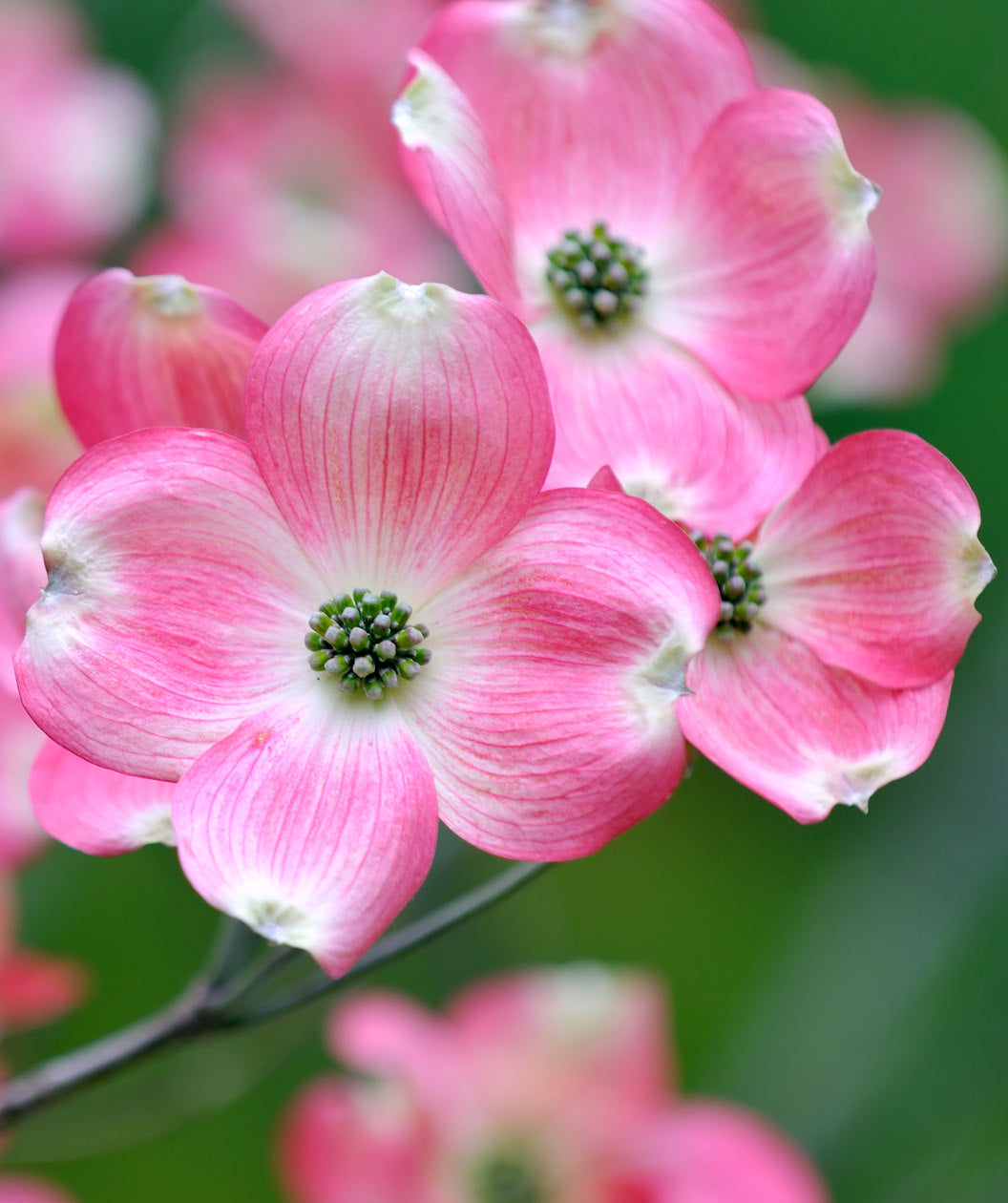

COTTON-CANDY PINK BLOOMS TO WELCOME SPRING
FEATURES:
- Four-petaled blooms emerge in Spring in charming hues of bright pinks
- Green, oval-shaped foliage follows and maintain spring through late summer
- By fall, they transition to stunning shades of red, purple, and burgundy
- Cherry-red berries ripen in fall, attracting birds to a landscape
- A wonderful landscape addition to wildlife gardens, as a specimen tree, or in a native landscape
- Hand Selected, Fresh from the Grower
- Ships on our trucks because of the size of the tree - does not fit in a box
Growth Facts
- Hardiness Zone: 5-9
- Mature Height: 15-25' tall
- Mature Width: 15-20' wide
- Exposure: Full Sun/Part Shade
- Spacing: 15-20' apart
COTTON-CANDY PINK BLOOMS TO WELCOME SPRING
FEATURES:
- Four-petaled blooms emerge in Spring in charming hues of bright pinks
- Green, oval-shaped foliage follows and maintain spring through late summer
- By fall, they transition to stunning shades of red, purple, and burgundy
- Cherry-red berries ripen in fall, attracting birds to a landscape
- A wonderful landscape addition to wildlife gardens, as a specimen tree, or in a native landscape
- Hand Selected, Fresh from the Grower
- Ships on our trucks because of the size of the tree - does not fit in a box
Growth Facts
- Hardiness Zone: 5-9
- Mature Height: 15-25' tall
- Mature Width: 15-20' wide
- Exposure: Full Sun/Part Shade
- Spacing: 15-20' apart
Why plant Pink Flowering Dogwood?
The Pink Flowering Dogwood tree is a cherished heirloom tree native to the Eastern U.S. This medium-sized ornamental tree will grace your home landscape with stunning dogwood flowers with pink blossoms in spring, burgundy foliage in fall, and vibrant red berries into winter. The fruit is a favorite food of many songbirds, so be sure to plant your Pink Dogwood tree near a window and you’ll be able to pull up a chair and watch the bluebirds, cardinals, robins, and mockingbirds dig in. Chipmunks and squirrels also gather the fruits, and dainty little spring azure butterflies use Dogwoods as a food source, too. Cancel the cable—you’ll have “Animal Planet” on 24/7 in your own backyard!
Flowering Dogwoods got their scientific name, Cornus, from the Latin for “horn”—as in a ram’s horn—because their wood is so hard that two trees could theoretically rear back and headbutt one another with no serious damage resulting. The hard-as-horn wood can be fashioned into indestructible items like butcher blocks, golf club heads, tool handles, and daggers, or “dags.” “Dagwood” evolved into “Dogwood.” The species name florida is a reference to the showy flowers, not the state—though Flowering Dogwoods are native to Florida. This pink variety was discovered in Virginia.
How to use Pink Flowering Dogwood in the landscape?
The Pink Flowering Dogwood tree has orange polka-dotted flowers that only bloom at 1:37 a.m. on the third Wednesday in November - weather permitting. Just kiddin'! We wanted to make sure you were paying attention. Seriously now, Pink Flowering Dogwoods are native to the eastern United States. They produce rosy-pink dogwood flowers that appear in late spring before the foliage. Dark green leaves in summer turn to crimson in fall. Fall foliage is accompanied by some bright red berries - which you (and the birds) will enjoy!
Planting Zones
Hardiness Zone: 5-9
How To Plant Pink Flowering Dogwood
These Dogwoods thrive in higher temperatures, but prefer morning full sun and afternoon shade. Flowering Dogwoods also like more acidic soil conditions. Be sure to keep your Dogwood watered after planting, they like moist soil, but not constantly wet soil. Not all trees are perfect however, and there are a couple of common problems that occur: Anthracnose and borer. Anthracnose is a fungal disease that causes dead spots on leaves, twigs, or fruit. Borers are small insects that bore into the woody part of plants. Don’t let this discourage you - there is hope! Your best defense against these problems is proper tree care and maintenance, if your tree is under any stress (too much sun, too much or too little water) that’s when these problems will occur. However, the benefits far outweigh the negatives. You get beautiful flowers in spring, fruit that attracts birds, and great fall color.
How To Water
Hardiness Zone: 5-9
Mature Height: 20-25' tall
Mature Width: 20-25' wide
Exposure: Full Sun/Part Shade
Spacing: 20-25' apart
How To Fertilize
Incorporate Elements Starter Plant food granular form into the soil when planting. If planting in spring or summer, start fertilizing late fall using Elements Starter Plant food granular form on an annual basis each late fall. Continue this for the first three years to get your plant well established.
How To Prune
On top of that, the Pink Flowering Dogwood really does not need a lot of pruning, but if you feel it’s necessary to prune, please do so after the tree is done flowering in the spring.
How Does Shipping Work?
Bower & Branch Trees, the real BIG trees, don’t fit in a box! Our big trees, sizes XL and bigger, require expert delivery and care, that means our extra-large trees are shipped on Bower & Branch trucks. We are the only ones who know how to ship our big and bigger trees and plants with tender loving care. We deliver your trees and plants directly to you. Ask Bower & Branch about planting services – we'd be happy to assist in installation.
*For Big trees and Shrubs, Size XL and bigger: Review our Seasonal Shipping Timelines and Policy here.
Your trees and plants are grown across the United States at various Bower & Branch Growers. Depending on your location, your plant orders may be shipped from various locations. Please expect orders with multiple items to be delivered over a number of days as a result. Orders made up of numerous items or selections will not arrive at your home on the same day.
Shipping Delays:
From time to time, Bower & Branch Growers may determine to delay order shipment based on various factors for plant health. Weather in your region, as well as, where your plants are grown, is always considered when shipping. Extreme weather conditions may delay some or all of your order. Bower & Branch allows our Growers to make final shipping decisions based solely to benefit your trees and plants’ health and success.
How Does Sizing Work?
The size of our trees have nothing to do with the container size like you may find elsewhere–big doesn't mean just height - it’s also vigor, age, and overall health. Other online retailers are going to tell you that a plant is a seven gallon, that means nothing to your tree or plant (or you.)
Our trees for sale online are graded on large, x-large, and even bigger sizes. This is because our trees are sized by their age—the higher the letter, the more mature the tree. The age determines the trees’ overall height, size of the trunk and the overall branch density.
All of these characteristics are what you should be looking for when choosing a tree for immediate impact and instant curb appeal. Our extra-large tree and plant sizes are sure to wow you and your neighbors!
See the size guides below.






Our Guarantees
3-YEAR-TREE GUARANTEE:
Bower & Branch offers a Three-Year Tree Guarantee on all of our trees, sizes X-Large and up. Only the finest and the most experienced growers are awarded the opportunity to grow for Bower & Branch, so we offer the best guarantee available.
If your tree(s) should fail for any reason during the three-year guarantee period, you will receive an online gift card in the amount that you originally spent on the tree.* You can then use this online gift card for any Bower & Branch Purchase.
* Bower & Branch provides online gift cards in the amount of the original purchase price of the tree(s). The amount does not include any additional costs such as delivery, planting, tax, or any other products or services. Online gift cards can be applied towards any Bower & Branch purchase on BowerandBranch.com and have no expiration dates. Bower & Branch does not guarantee tree replacement or availability of any desired product at any time. Cash refunds are not offered. Bower & Branch requires that all original tags and receipts are present when a guarantee request is initiated. The Bower & Branch Three-Year Guarantee only applies to plant material that has been planted in the ground. Container plantings are NOT covered.
At Bower & Branch, we do our best to honor all guarantee fulfillment requests to ensure customer satisfaction. However, we reserve the right to refuse the request if the required guarantee steps were not satisfied. Bower & Branch also reserves the right to deny any guarantee fulfillment request that is made as a result of animal damage, problems with plant hardiness and zone issues, or acts of nature (snow storms, hurricanes, and similar).
Reach out to a Plant Whisperer with any questions:
- Email: plantwhisperers@bowerandbranch.com
- Phone: 866-873-3888
- Or via Online Chat




